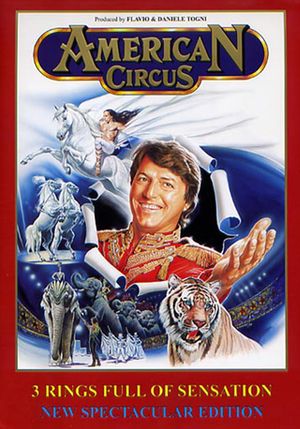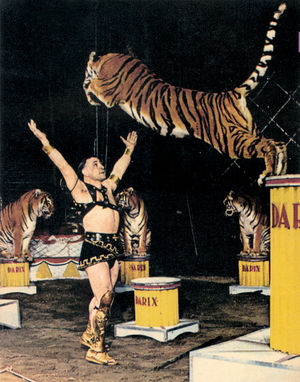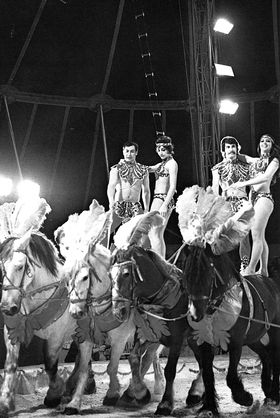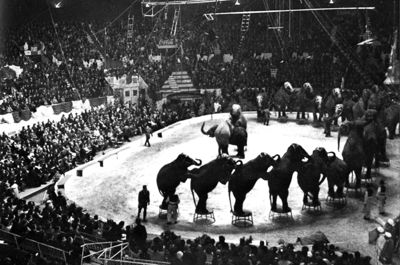The Togni Family
From Circopedia
Circus Owners, Equestrians, Animal Trainers, Acrobats, Aerialists
By Raffaele De Ritis
The Togni family is one of the largest Italian circus dynasties still active today. It has produced, over a century, excellent acrobats, animal trainers, and several circus managers, who have created dozens of traveling circuses and have toured in about thirty countries. The Tognis have also always excelled in circus engineering: they are credited with several technical innovations, including the introduction of three of the world's most commonly used big topThe circus tent. America: The main tent of a traveling circus, where the show is performed, as opposed to the other tops. (French, Russian: Chapiteau) systems today: the round cupola (in the 1940s), the "Italian" oblong cupola (in the 1970s), the quarterpole(American) A support pole placed midway between the main poles and the sidewall of a circus tent.-free big topThe circus tent. America: The main tent of a traveling circus, where the show is performed, as opposed to the other tops. (French, Russian: Chapiteau) (also in the 1970s), and the round-cupola, quarterpole(American) A support pole placed midway between the main poles and the sidewall of a circus tent.-free "Florilegio" big topThe circus tent. America: The main tent of a traveling circus, where the show is performed, as opposed to the other tops. (French, Russian: Chapiteau) (in the 1990s).
Origins
The dynasty was founded by Aristide Togni (1853-1924), a university student who, in the 1870s, ran away and joined the Circo Torinese, a circus company headed by Giovanni De Bianchi. Like many Italian circuses at the time, the Circo Torinese performed on stage, in theaters. De Bianchi had married Maria de la Garenne (a.k.a. de Lagarein), a Sinti gypsy, who was said to be the granddaughter of a French nobleman who had fled to Italy during the French revolution.
Togni married Giovanni's daughter, Teresa De Bianchi. Together, they created a circus company of their own—which, as legend has it, consisted of a single wagon and a monkey—and headed for the South of Italy. Circa 1880, they had acquired a small, one-pole big topThe circus tent. America: The main tent of a traveling circus, where the show is performed, as opposed to the other tops. (French, Russian: Chapiteau) that could house an audience of forty: the first Circo Togni was born. The couple had eight children, and their circus grew quickly, soon performing under a medium-size big topThe circus tent. America: The main tent of a traveling circus, where the show is performed, as opposed to the other tops. (French, Russian: Chapiteau). It became so popular, apparently, that the King of Italy, Victor Emmanuel III, awarded Circo Togni the title of Circo Nazionale in 1919.
The Circo Nazionale Togni (1919-1951)
Aristide's succession was assured by three of his sons, Ercole (1894-1958), Ugo (1897-1981), and Ferdinando (1900-1990). The circus alternated summer seasons under the big topThe circus tent. America: The main tent of a traveling circus, where the show is performed, as opposed to the other tops. (French, Russian: Chapiteau) with winter engagements in some of the most beautiful theatres of Italy. For several years, they toured Sicily and Greece. In the 1930s, the Dopolavoro Fascista (the entertainment office of the Fascist government) supported the Circo Nazional Togni, which it considered a major artistic propaganda tool.The circus began to travel with a menagerie, which included tigers, lions, bears, elephants, and an important collection of horses. Ferdinando became a fine horse trainer and presented beautiful "liberty"Liberty act", "Horses at liberty": Unmounted horses presented from the center of the ring by an equestrian directing his charges with his voice, body movements, and signals from a ''chambrière'' (French), or long whip." horse acts; Ercole was the house clown and a good tumbler; Ugo was a perch-poleLong perch held vertically on a performer's shoulder or forehead, on the top of which an acrobat executes various balancing figures. acrobat, aerialistAny acrobat working above the ring on an aerial equipment such as trapeze, Roman Rings, Spanish web, etc., and animal trainer. There were also about twenty talented performers among their daughters and sons, and the company included members of other famous Italian circus families, such as Miletti, Jarz, and Casartelli.
The third Togni generation created the Tognis's three principal signature acts: pyramids on horseback, "jockeyClassic equestrian act in which the participants ride standing in various attitudes on a galoping horse, perform various jumps while on the horse, and from the ground to the horse, and perform classic horse-vaulting exercises.," and flying trapezeAerial act in which an acrobat is propelled from a trapeze to a catcher, or to another trapeze. (See also: Short-distance Flying Trapeze). By the late 1940s, Darix Togni (Ercole's son, 1922-1976) became, with his lion act, the starof Circo Nazionale Togni. In that act, Darix began to develop his legendary gladiator character. Circo Togni's large, round cupola allowed the presentation of the Tognis's spectacular cross-flying trapezeAerial act in which an acrobat is propelled from a trapeze to a catcher, or to another trapeze. (See also: Short-distance Flying Trapeze) act, which had no less than two catchers and nine flyers. Among those, Cesare Togni (Ugo's son) accomplished a double "casse-cou(French) A front, or forward, somersault." (front somersault) to the catcherIn an acrobatic or a flying act, the person whose role is to catch acrobats that have been propelled in the air., with a return to the bar with a triple pirouette(French) A full rotation of the body in the vertical axle. Double pirouette: two rotations, etc..
Although it survived and performed safely during WWII, the Circo Nazional Togni was devastated by a fire in 1951. Ercole, Ugo, and Ferdinando decided that it was time to split their ever-growing family within three separate circuses.
Ercole Togni and the Circo Darix Togni (1951-1980)
Ercole's children were Darix, Wioris, Wanet, Leda, and Doly. Their new circus took the name of Darix Togni, since Darix was the star of the family with his very popular lion and tiger acts. Darix and his brother Wioris (1923-2004) became excellent circus managers. Their circus had state-of-the art installations and equipment, and some of the finest performers of the time. The great Dutch equestrian Albert Carré joined the circus in the winter with his horse acts.Darix and Wioris organized successful tours in Greece, Cyprus, and Egypt, and Darix became one of the most popular figures in the history of the Italian circus: He was celebrated in newspapers and magazines, he mingled with movie stars, appeared with his big cats in several "peplum" movies, and performed in foreign circuses. In 1959, the Tognis conceived a special tent structure for the first Italian tour of the Moscow Circus.
Wioris introduced several important technical improvements to the circus world, such as collapsible seating wagons and the metallic-mesh cage. In 1963, after yet another disastrous fire, Darix and Wioris conceived a revolutionary ten-pole "tension tent," the first ever quarterpole(American) A support pole placed midway between the main poles and the sidewall of a circus tent.-free big topThe circus tent. America: The main tent of a traveling circus, where the show is performed, as opposed to the other tops. (French, Russian: Chapiteau). (By the 1950s, the Tognis had already introduced to the circus business the Anceschi and Canobbio families: they would become the world's leaders in the circus seating and tent imanufacturing, respectively.)
In the early 1970s, Darix and Wioris produced the lavish Circo nell'Acqua aquatic circus show, which toured Sweden under the management of François Bronett, and starring Katja Schumann. The circus folded its tent after Darix's death, in 1976. Wioris revived occasionally the Darix Togni name for a few years, before establishing himself, in the 1980s, as an Italian pioneer in the sport and concert arena business. He has been succeeded in that business by his son Divier (b.1949). Wioris's other son, Holer (b.1946), launched in the early 1970s a touring motor show, Stunt Cars, and became Italy's most famous stuntman. (About Darix's sons and legacy, see below, Florilegio.)
Ugo Togni and the circuses of Cesare and Lidia Togni
Ugo Togni had four daughters, Angly, Wally, Missi, and Lidia, and two sons, Cesare and Oscar. After the family split, they went to the United States in 1952 to perform their flying trapezeAerial act in which an acrobat is propelled from a trapeze to a catcher, or to another trapeze. (See also: Short-distance Flying Trapeze) act at the Mills Bros. circus. Angly joined the Justino Loyal bareback riding act, and married the acrobat Ugo Bogino. (Their son, Davis, became acrobatic teacher at the Académie Fratellini, one of France's two state circus colleges). Missi married perch-poleLong perch held vertically on a performer's shoulder or forehead, on the top of which an acrobat executes various balancing figures. acrobat Romualdo Simili; together they spent two seasons with Ringling Bros. and Barnum & Bailey with their perch-poleLong perch held vertically on a performer's shoulder or forehead, on the top of which an acrobat executes various balancing figures. act. Wally married artist and future circus impresario Leonida Casartelli, generating another important dynasty.Cesare (1924-2008) and Oscar (b.1929), who had been fascinated by the giant American three-ring circuses, launched the colossal, three-ring Circo Massimo in Rome in 1956, perhaps the largest circus tent ever built in Europe. But they quickly returned to a one-ring format to present a water pantomimeA circus play, not necessarily mute, with a dramatic story-line (a regular feature in 18th and 19th century circus performances)., the equipment of which they had purchased from the circus Appolo after it folded its tent. Later, while Oscar started a smaller circus on his own, Cesare created his Circo Cesare Togni, which became, in the 1970s, one of the most popular circuses in Italy.
Cesare's children (Elvio, Alex, Italo, and Viviana) excelled as acrobats, aerialists, equestrians, and elephant and horse trainers: They formed one of the most talented "house companies" of the period, and were joined in their shows by first-class guest performers. They liked reviving forgotten classics from the equestrian repertory—or from other specialties, such as their remarkable grande batoude(French) A long wooden tramplin that acrobats use to jump over other performers, horses, or elephants, notably in the charivari. Also called "grande batoude". tumbling display.
In 1983, Cesare Togni returned to the three-ring format, and toured Yugoslavia, Greece, Turkey, and Malta, while Oscar briefly operated an Italian tour of Las Vegas Circus Circus, in association with the famous casino-hotel in Las Vegas. Oscar's son, Mike, performed successfully in Las Vegas showrooms a tumbling act with his cousin Ottaviano Simili (the son of Romualdo Simili and Missi Togni), which included chimpanzees. Oscar Togni opened a small Circo Oscar Togni in the 1990s, which had only a brief existence. Today, his sons performed their bareback riding and elephant acts in various European circus.
Cesare's sister, Lidia (b.1931), married Riccardo Canestrelli. They formed in the 1970s the three-ring Circo Royal, which closed after just a few years. Her sons, Vinicio and Davide, worked as animal trainers with Firmin Bouglione's Cirque Amar, in France, and eventually created, in the 1980s, their own Circo Lidia Togni, which became one of Europe's largest circuses. It visited Mediterranean countries with top-class equestrian acts, lavish production numbers replete with a batallion of showgirls, and ever-changing productions—such as the two-ring Circus on Ice (2004-2007), the equestrian spectacular Cavallomania (2007), and the Circo Latino Americano (2008-2009).
Ferdinando Togni and "Circo Americano"
After WWII, Ferdinando Togni created one of the Europe's most remarkable circus enterprises of the post-war era with his children Adriana (b.1928), Bruno (1931-1988), Willy (1929-2007), and Enis (1933-2016). In 1954, they launched the Circo Ferdinando Togni, which quickly acquired a great reputation for its equestrian presentations and its cage acts with Bruno's lions and Enis's tigers.
The circus grew in size, and toured in Switzerland, Austria, and Germany, and in the winter of 1959, temporarily merged with Germany's Circus Williams, whose name it took. By 1960, the Tognis started a big three-ring circus called Circo Heros: It was one of Europe's largest circuses, and for a decade, it toured regularly in Italy, Germany, and Holland.
Beginning in November 1963, to counteract a European tour of Ringling Bros. and Barnum & Bailey (whose disastrous tour never went that far south), the Tognis and Carola Williams joined forces with Spanish producers Arturo Castilla and Manuel Feijóo, and presented a mammoth version of Circo Americano—a Castilla-Feijóo show operating in Spain since 1949—in Italian sport arenas. The Castilla-Togni-Williams "Americano" edition boosted a group of 25 elephants, three rings of liberty"Liberty act", "Horses at liberty": Unmounted horses presented from the center of the ring by an equestrian directing his charges with his voice, body movements, and signals from a ''chambrière'' (French), or long whip. horses, and a stellar cast that would have dwarfed the American giant.In 1964 the Tognis toured under the banner of Circus Knie in Italy, and often changed their name afterwards, merging again their show with Carola Williams's (under the name Circo di Berlino), or with Castilla's (under the name Circo di Madrid). After switching the names Heros and Americano all through the 1960s, the Ferdinando Togni family stuck definitely with Circo Americano in 1975.
Meanwhile, the family participated in other important ventures: an Italian tour of the Moscow Circus (1969); their own lavish production, Circo de Mexico (1970-71), in Italy and Yugoslavia; the Disney on Parade show (1972); the Enis Togni Circus in Great Britain with Mary Chipperfield (1972); the Billy Smart's Circus in Italy (1975); and pop-music concert tours under the big topThe circus tent. America: The main tent of a traveling circus, where the show is performed, as opposed to the other tops. (French, Russian: Chapiteau). But Circo Americano (sometimes retitled American Circus), with its sumptuous three-ring productions and all-star casts, established itself as the family's flagship, and by far the largest European traveling circus. Willy Togni presented one of the world's largest elephant groups, and Bruno reigned over 80 horses, while Enis took care of the business side of the organization.
In 1976, Americano's big topThe circus tent. America: The main tent of a traveling circus, where the show is performed, as opposed to the other tops. (French, Russian: Chapiteau) and equipment were chosen to host the International Circus Festival of Monte Carlo, and its artistic staff to run the show. For 12 years, Enis, Willy and Bruno Togni acted respectively as managing, technical and performance directors of the Festival.
In the 1970s, Circo Americano began to visit regularly Spain, France, Germany, Austria, Belgium, Holland, and Yugoslavia, with spectacular advertising campaigns and considerable success. A new generation gradually appeared, taking over animal acts and equestrian presentations. In the late 1970s, the legendary flying trapezeAerial act in which an acrobat is propelled from a trapeze to a catcher, or to another trapeze. (See also: Short-distance Flying Trapeze) catcherIn an acrobatic or a flying act, the person whose role is to catch acrobats that have been propelled in the air. Lee Stath created for the Togni juniors a double-catcherIn an acrobatic or a flying act, the person whose role is to catch acrobats that have been propelled in the air. flying actAny aerial act in which an acrobat is propelled in the air from one point to another., the Togni-Marilees, featuring the great American flyerAn acrobat that is propelled in the air, either in a flying act, or in an acrobatic act (i.e. teeterboard)., Don Martinez, who turned a rare triple-and-a-half somersault to the catcherIn an acrobatic or a flying act, the person whose role is to catch acrobats that have been propelled in the air..The new star of the family was Enis's son, Flavio (b.1960): His elephant and horse presentations won him three Silver Clowns at the International Circus Festival of Monte Carlo. For the 1991 and 1992 seasons, the entire Circo Americano was booked by Kenneth Feld and brought to the United States, where the Togni family acts starred in the new Ringling Bros. and Barnum & Bailey production. In 2008, Flavio started creating animal acts (tigers and elephants) for major European circuses (Arlette Gruss and the Cirque d'Hiver-Bouglione in France, or Cirkus Maximum in Sweden).
Willy's sons, Marco and Loris, left the circus (after a remarkable career as flyers) in the 1990s, and became successful illusionists. Bruno's son, Andrea, is a remarkable aerialistAny acrobat working above the ring on an aerial equipment such as trapeze, Roman Rings, Spanish web, etc. and the Director of the Accademia del Circo, the Italian circus school in Verona. Adriana's daughter, Cristina, is an excellent horse trainer. Enis's other son, Daniele was in charge of the management of Circo Americano (renamed American Circus in the 1990s), and was replaced by Flavio in the late 1990s. Flavio's son, Bruno, has become a remarkable tiger trainer.
The Darix Togni legacy: "Florilegio"
Livio, Corrado, Davio Nevia, and Danila were the children of Darix Togni. While Danila married performer Renzo Larible, her brothers launched the Jumbo Super Circus in 1974: a gigantic operation inspired by the French Cirque Pinder of the 1950s (from which they acquired the fabled street parade vehicles). In 1978, they reduced the size of their circus and renamed it I Figli di Darix Togni (Darix Togni's Sons), before it became the new Circo Darix Togni in 1986, making the name famous in Greece and Turkey as well.In April 1990, in Paris' Bois de Boulogne, Livio Togni (b.1950) and his brothers inaugurated Il Florilegio di Darix Togni: A new concept that played up to audiences' nostalgia for old family circuses, with a revolutionary big topThe circus tent. America: The main tent of a traveling circus, where the show is performed, as opposed to the other tops. (French, Russian: Chapiteau) architecture and one of the largest menageries of the period. Corrado (b.1953) revealed himself as a remarkable clownGeneric term for all clowns and augustes. '''Specific:''' In Europe, the elegant, whiteface character who plays the role of the straight man to the Auguste in a clown team., while Davio (b.1959) presented unusual animals acts, including a leopard riding a rhinoceros.
Their revolutionary big topThe circus tent. America: The main tent of a traveling circus, where the show is performed, as opposed to the other tops. (French, Russian: Chapiteau) became the most widely copied circus structure in the world. Il Florilegio was un unmitigated success in Italy, France, Belgium, Great Britain, Ireland, Holland, Germany, Luxembourg, Bulgaria, Hungary, Greece, and Turkey for more than a decade, often attended by royalty and celebrities. Then, in 2002, Livio Togni was elected to the Italian Senate, and left the circus.
By 2006, the family operated three circus units: Il Florilegio – Amar in Algeria, a two-ring circus with a circus-on-ice part managed by Livio Togni's sons, Max and Steve; another unit named Darix Togni, managed by Davio Togni, which successfully performed for two consecutive years (2007 and 2008) in Teheran, Iran; and a third unit which was occasionally used during the winter in Italy or France. Faced with the increasing difficulty to present wild animals in most of Europe, Davio Togni then moved to Russia with his company and his animals, where he has since been touring successfully (as of 2024).
Suggested Reading
- Alessandra Litta Modignani, Sandra Montovani, Il circo della memoria (Trento, Publistampa Edizioni, 2008) — ISBN 978-88-902506-7-5
- Jamila Attou, Ester Bonfante, Arianna Pianesi, Darix Togni, dal Nazionale al Florilegio (Verona, Edizioni Equilibrando, 2023) — ISBN 978-88-95424286
See Also
- Biographies: Darix Togni, Cesare Togni
- Video: Bruno Togni, liberty act, at Circo Americano-Togni (1974)
- Video: Willy Togni, elephant act, at Circo Americano-Togni (1974)
- Video: Flavio Togni, elephants and horses, at the International Circus Festival of Monte Carlo (1983)
- Video: Flavio Togni, elephant act at the Spodek Arena in Poland (1988)
- Video: Davio Togni, hippo, rhino and leopard act at Il Fiorilegio di Darix Togni (c.1995)
- Video: The American Circus in Genoa, Documentary (2009)
- Video: Flavio Togni, elephant act, at the International Circus Festival of Monte Carlo (2011)
- Video: Flavio Togni, tiger act, at the International Circus Festival of Monte Carlo (2011)
- Video: Vinicio Togni-Canestrelli, liberty act, at the International Circus Festival of Monte Carlo (2014)
- Video: Flavio Togni and Alexis Gruss, horses at liberty, at the 40th International Circus Festicval of Monte Carlo (2016)
- Video: Adriana & Sarah Togni, double trapeze, at Circus Kronebau in Munich (2017)
- Video: Bruno Togni, Tiger act, at Circus Nikulin in Moscow (2020)
- Video: Enoys Gonçalves & Enis Togni, hand balancing and Chinese pole, at Circus Nikulin in Moscow (2020)
- Video: Bruno Togni, tiger act, at the International Circus Festival of Monte Carlo (2023)
External Links
- Circo Lidia Togni: www.lidiatogni.it and www.circolidiatogni.com
- Circo Americano Togni: www.american-circus.com
- Circo Darix Togni: www.circotogni.it
- Il Florilegio: www.florilegio.com
























